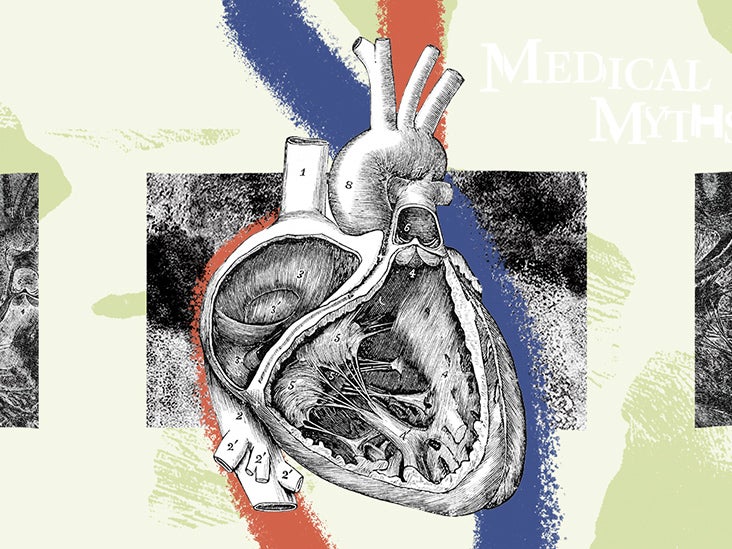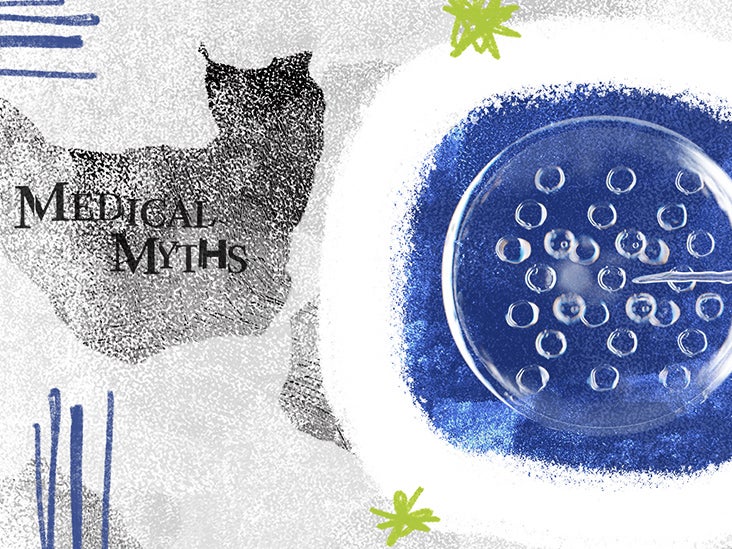15 breast cancer myths busted

According to the World Health Organization (WHO), in 2020, 685,000 people died from breast cancer, and 2.3 million received a diagnosis. It reported:
“As of the end of 2020, there were 7.8 million women alive who were diagnosed with breast cancer in the past 5 years, making it the world’s most prevalent cancer.”
Its prevalence might help explain why there is a wide range of myths attached to it. Here, we will tackle 15 of the most common misunderstandings.
To help us reach the truth, we enlisted the help of three experts:
- Dr. Michael Zeidman: an assistant professor of breast surgery at Icahn School of Medicine at Mount Sinai in New York City.
- Dr. Crystal Fancher: a surgical breast oncologist at the Margie Petersen Breast Center at Providence Saint John’s Health Center and assistant professor of surgery at the Saint John’s Cancer Institute in Santa Monica, CA.
- Dr. Richard Reitherman, Ph.D.: the medical director of breast imaging at MemorialCare Breast Center at Orange Coast Medical Center in Fountain Valley, CA.
1. A breast injury can cause breast cancer
“Injury to the breast cannot cause breast cancer,” explained Dr. Zeidman, “however, it can cause changes in the breast that may mimic breast cancer on imaging.”
“This process is called ‘fat necrosis,” he continued, “and it can look like an irregular mass with jagged edges on a mammogram, much like the appearance of a new breast cancer. The best way to distinguish cancer from fat necrosis is with a needle biopsy.”
2. Underwire bras increase the risk of breast cancer
Although underwire bras do not increase breast cancer risk, Dr. Zeidman always recommends bras without a wire. He explains:
“The wire can irritate the skin under the breast, which can lead to skin breakdown. This breakdown may allow bacteria to enter the breast causing infection, [an] abscess, [or both].”
3. IVF increases the risk of breast cancer
As part of the in vitro fertilization (IVF) procedure, doctors often prescribe drugs that stimulate the ovaries to produce eggs. These drugs mimic the activity of estrogen.
Because of this, some experts wondered whether they might encourage the growth of estrogen receptor-positive breast cancer. As the name suggests, these cancer cells have estrogen receptors on their membranes.
“While there are no randomized controlled trials looking to answer this question,” explained Dr. Zeidman, “a recent meta-analysis of all observational studies over the past 30 years concluded that there is no increase in breast cancer risk for women who received ovarian stimulation drugs compared with the general population.”
4. No one in my family had breast cancer, so I won’t develop it
This is a myth that Dr. Zeidman is familiar with, he told Medical News Today: “It is very common for [people] with a new breast cancer diagnosis to tell me how shocked they are considering that they have no family history.”
“I then respond by stating that the vast majority of [people who] I see with a new breast cancer have no risk factors. In fact, the most significant risk factor for developing breast cancer is being a woman. In the United States, 1 in 8 women will develop breast cancer over their lifetime.”
As Dr. Fancher explained to us, “only about 5–10% of breast cancers are caused by a genetic mutation that is passed between family members. This means that the majority of breast cancers are sporadic or have no hereditary cause.”
Because family history is only one factor in the risk of breast cancer, screening is important. As Dr. Reitherman explained:
“The message is that every woman starting at 40 years of age should have a yearly mammogram regardless of a family history of breast cancer. Those women with a family history of breast or ovarian cancer should be evaluated by a genetics counselor by the age of 30. This group of women may need to begin breast cancer screening prior to the age of 40.”
Dr. Zeidman takes the opportunity to stress the importance of checkups:
“If you are a woman and at least 40 years old, please get your screening mammograms!”
5. Being stressed can cause breast cancer
With the ever-present stresses of modern life, it is no surprise that people are concerned about how stress might impact health.
However, as Dr. Zeidman told us, “There is absolutely no evidence to support a link between stress and breast cancer. In fact, there is evidence to support that stress does not increase breast cancer risk.”
That is not to say that stress cannot impact health at all, however. He goes on: “Part of being human is finding effective ways to deal with the stress we all will inevitably face. This can have profound health benefits both mentally and physically, but will do nothing to mitigate breast cancer risk.”
6. A healthy lifestyle eliminates breast cancer risk
“While it is true that postmenopausal women who are overweight are at an increased risk of developing breast cancer, there is nothing that a woman can do to eliminate breast cancer risk,” explained Dr. Zeidman.
“Even women who undergo bilateral mastectomy are still at risk of developing a new breast cancer.”
However, he is not suggesting anyone starts “smoking and eating fast food every day.”
More generally, he believes that “it is of the utmost importance to take care of your body because you only get one. But even world class athletes have been diagnosed with breast cancer.”
7. Breast cancer only happens to older adults
“While it is true that breast cancer risk increases as women age, and the average age of a new breast cancer diagnosis is 61 years, breast cancer can occur much earlier,” Dr. Zeidman told MNT.
“About 5% of new breast cancer diagnoses are in women under the age of 40 years. There, unfortunately, have been reports of women in their early 20s and even teens who were diagnosed. There is typically a strong family history in these young women.”
“If you have a significant lifetime breast cancer risk based on a strong family history, then you may qualify for genetic testing and early screening starting at age 25.”
Dr. Fancher explains that, although breast cancer is rarer in younger people, she encourages people to “bring any concerning findings in your breast to your doctor’s attention and follow their recommended screening guidelines.”
![]()



8. All lumps in the breast signal breast cancer
This is a myth — not all lumps in the breast are cancer. Dr. Zeidman explained that the majority “of new breast lumps are benign. And, if you had a recent mammogram that was normal, then that percentage is likely even higher.”
However, Dr. Zeidman made it clear that any new lump should be “evaluated by a healthcare professional.”
9. Having an abortion increases the risk of breast cancer
“The reason this question comes up is because we know that breast cancer risk is directly related to estrogen exposure,” Dr. Zeidman told us, “and abortion interrupts the normal hormonal cycle of pregnancy.”
“While we can never perform a randomized controlled trial to address this question, there was a very large observational study in Denmark that included 1.5 million women and found no link between abortion and breast cancer.”
Aside from this analysis, he explained that there have also “been several other large-scale studies that came to the same conclusion.”
10. Carrying a phone in your bra can cause cancer
According to Dr. Zeidman: “There is no evidence to support that cell phones cause cancer, period.”
“However, we do not have any long-term studies, so we may find this to be the case in the future. For now, why can’t you just put your phone in your pocket or bag?”
11. Nipple piercings increase breast cancer risk
Dr. Zeidman told MNT that this is a myth — nipple piercings do not increase breast cancer risk.
“However,” he elaborated, “they can lead to complications, such as infection, abscess, difficulty breastfeeding due to blocked ducts from scar tissue, nerve damage, keloids, cysts, and more rare but serious illness from HIV and hepatitis B and C.”
“For these reasons,” he said, “I always recommend against nipple piercing. If the deed is done, I recommend removing it.”
12. Sugar causes breast cancer
Dr. Zeidman maintains a firm stance on sugar: “Sugar should be avoided in general. It is addictive.”
“It can cause mood swings,” he continued, “It leads to spikes in insulin, which puts the body in a pro-inflammatory state. This, in turn, can lead to heart disease, diabetes, and other chronic inflammatory diseases.”
“Too much sugar can result in obesity, which is a risk factor for breast cancer.”
However, he explained that studies investigating links between sugar and breast cancer have been “mixed and inconsistent.”
While discussing sugar, it is worth busting a related myth: that sugar helps tumors grow. This myth arose because cancer cells divide rapidly and, therefore, need a lot of energy.
“While there is no concrete evidence to support this,” stated Dr. Zeidman, “I still recommend abstaining from added sugar as much as possible for overall well-being.”
13. Men do not get breast cancer
“Men have breasts… so yes, they too get breast cancer,” said Dr. Zeidman. “In fact, 1% of all breast cancer diagnoses in the U.S. are in men.”
According to the Centers for Disease Control and Prevention (CDC), there were 2,300 new cases of male breast cancer in 2017 and 500 deaths.
“While breast cancer is more common in women than men, there are still men who get breast cancer,” explained Dr. Fancher, “It’s important for men also to be aware of any changes in their breast since there are no recommended screening guidelines for men.”
“Any lump, pain, or changes should be brought to your doctor’s attention, even if you don’t have a strong family history.”
– Dr. Fancher
Dr. Reitherman added, “Men are diagnosed with breast cancer rarely […] the most common risk factor is a family history of breast cancer. The BRCA2 genetic mutation markedly increased the risk of breast cancer in males who carry this gene.”
14. Mammograms cause breast cancer to spread
“This is a common misconception that I hear from my patients,” Dr. Zeidman told us.
“The thinking is that squeezing the cancer with compression during mammography, or performing a needle biopsy on the cancer, will cause the cancer to seed other parts of the breast.” However, he confirms:
“There is absolutely no evidence to support this.”
Dr. Reitherman agrees: “There is absolutely no evidence that mammograms cause breast cancer. The performance of a mammogram uses a very low dose of radiation and compression and has no documented or theoretical relationship to causing breast cancer.”
15. If there is no lump, there is no cancer
“If this were true, then we would not need mammograms,” said Dr. Zeidman. “Mammograms have been proven to save lives because they allow us to catch the cancer before it becomes palpable,”
In this context, “palpable” means that a person can feel the lump with their fingers.
“If we diagnose and treat a breast cancer while it is stage 1, survival approaches 100%. Survival drops as the stage advances. In fact, the cancer may never be palpable and still spread to other parts of the body,” Dr. Zeidman added.
According to Dr. Fancher, “Many breast cancers are found on screening mammograms and may not be felt. This is especially true for noninvasive breast cancer or ductal carcinoma in situ, which may only show up as calcifications on a screening mammogram.”
The take-home
Breast cancer is common, and while a healthy lifestyle might reduce the risk to a certain extent, vigilance is key. The earlier a doctor catches breast cancer, the higher the chances of surviving it.
After completing a bachelor’s degree in neuroscience at the U.K.’s University of Manchester, Tim changed course entirely to work in sales, marketing, and analysis. Realizing that his heart truly lies with science and writing, he changed course once more and joined the Medical News Today team as a News Writer. Now Senior Editor for news, Tim leads a team of top notch writers and editors, who report on the latest medical research from peer reviewed journals; he also pens a few articles himself. When he gets the chance, he enjoys listening to the heaviest metal, watching the birds in his garden, thinking about dinosaurs, and wrestling with his children.
You can follow Tim on Twitter.

![]()



Source: Read Full Article
